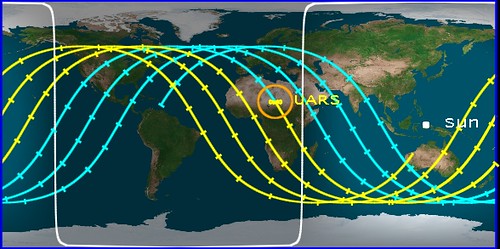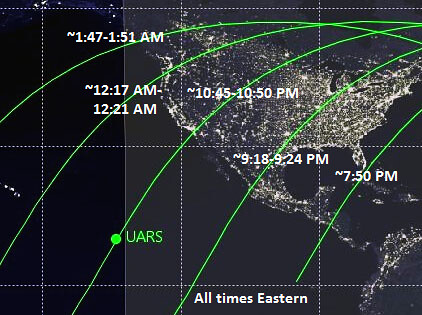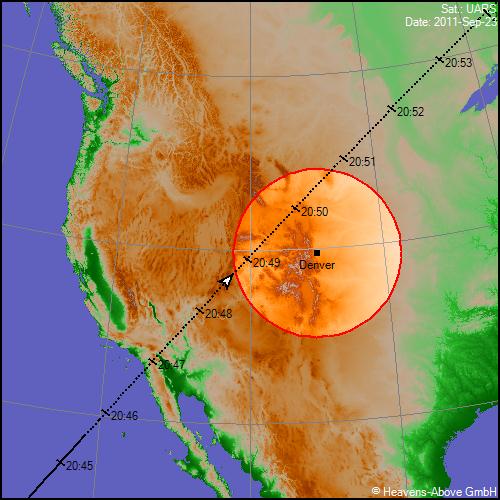[NOTE: For the latest, follow @UARS_Reentry on Twitter.]
NASA’s Upper Atmosphere Research Satellite, better known as “UARS,” will soon crash back to Earth in an uncontrolled re-entry. NASA previously thought this would happen this afternoon, which meant North America was seemingly out of the woods. But according to an update this morning, the satellite’s descent has slowed, and re-entry is now expected late tonight or early tomorrow, Eastern Daylight Time. The Aerospace Corporation’s Center for Orbital and Reentry Debris Studies is currently predicting a re-entry time of 11:16 PM Eastern — plus or minus five hours.
Because the satellite orbits the globe every 90 minutes or so, that broad range of uncertainty (which will narrow as we get closer to crashdown/splashdown) means a whole lot of land and ocean is potentially in its path. Specifically:
So the odds are, it won’t hit the U.S., or anywhere near the U.S. But it could! And so, let’s get a little parochial. Here’s an UNOFFICIAL map that I created, using this map from The Weather Space as my starting point, then adding APPROXIMATE times (based on data from Heavens Above and the above map by the Aerospace Corporation), showing ROUGHLY the time windows when UARS will be passing near or over the U.S. tonight, if it stays aloft long enough to reach each of these arcs in its orbit:
As you can see, if it re-enters a half-hour earlier than its predicted ~11:16 PM EDT time, or an hour later (or 2 hours earlier, or 2 1/2 hours later), it could be over or near the U.S. or Canada.
And now, to get even more parochial… if the timing is juuuuust right, it might be visible from Denver!
That’s from Heavens Above. The dotted line means the satellite will be in Earth’s shadow (which is another way of saying we’ll be long past sunset when it flies over), so it won’t be visible unless it’s in the process of re-entering the atmosphere. But if that happens to be the case, it’ll be awesome!
I’m crossing my fingers — the odds of satellite pieces injuring anyone or causing serious damage is very, very low, even if it does come in over land, because the vast majority of land area is unpopulated. However, as I mentioned yesterday, the odds of a spectacular light show are high, if UARS re-enters in an area where it’s visible:
As the satellite descends to an altitude of about 50 miles (80 kilometers), friction with the atmosphere is converted to light and heat. As it moves on a relatively slow – one could almost use the adjective “majestic” – flight across the sky, what is usually seen is a long trail of light and sparks that can take on virtually every color of the rainbow.
Small chunks of the satellite may be seen to break off and trail behind the main body. (NASA expects up to 26 pieces from UARS to survive re-entry and reach the ground.) If the re-entry occurs at night, it could light up the sky with a brilliance that easily rivals the full moon. Even if it occurs during the daytime, the satellite’s fiery passage across the sky could be readily seen.
Notes veteran satellite watcher Kevin Fetter: “A nice sized [satellite] with a uncontrolled re-entry. What a nice light show it should put on, if the decay occurs where people can see it.”
Can I get an 10:50 PM Eastern Time (8:50 PM Mountain Time) re-entry? LET’S MAKE THIS HAPPEN, PEOPLE!




And it turns out that according to NASA via Reuters per redOrbit.com — now why does that url remind me of Sputnik? :> — it’s still unknown just where the Spashdown(s) and/or Landing(s) occurred:
Actually, I kinda like that. There are still Some things that They don’t know. (Possibly also now including, by the way, the correct Value of the Cosmic Speed Limit — if Any. 🙂
Surely we will find out where it landed a bit after the landed debris goes up for sale on eBay ?
As for the Cosmic Speed Limit, the way I understand it is as a limitation, not a limit … starting from rest, it is supposed to be impossible to actually achieve the speed of light in a vacuum with anything which has rest mass, as long as we are restricted to using currently-known science …
With that said, however, it is/was/is supposed to be theoretically possible to have something with measurable rest mass go faster than the speed of light as long as it didn’t have to actually go at the speed of light itself at some time during its existence … now, how that can be achieved is beyond *my * scientific/engineering knowledge – but it does appear, at this moment, to have been at least challenged by this new set of observations …
With *that* said, it was observed with neutrinos which are one example of zero rest mass particles …
Begorrah and bejaysus – what is *happenin’* to the Areas of Settled Science ? Next thing you’ll be tellin’ us that that classic example of an ASS – Anthropogenic Global Warmin’ just ain’t so ! Even tho The Goracle Has Spoke !
Well, looks like now we Do know, after all. Where the dead satellite splashed down, that is. South Pacific. O No, Canada! ;> I still liked it better when we thought maybe we’d Never know.
Well, at least it’s good to know that the USAF Space Commandos can Do that. / Um. I think. :>
But we STILL don’t know whether or not CERN’s mighty muon neutrinos broke the Speed Limit on their mad dash from Switzerland to Italy.
Nor (with apologies to Henri de Navarre) whether Laird Alasdair feels that Geneva is worth a measurable rest mass. ;} [Yeah, yeah: Oy Veh! :]
“We don’t allow faster-than-light neutrinos in here” said the bartender. A neutrino walks into a bar.
FTL FTW !
hee hee!! Excellent, AML 🙂